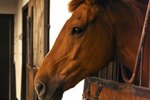
More commonly known as miniature donkeys, Sicilian donkeys actually arrived in Sicily via their native North Africa. Throughout the world, these hardy little equids carry people and goods and pull carts. They mature early, ready to work by the age of 3. Because they evolved in a harsh, dry environment, they don't require as much food as other similarly sized equids.
History
Donkeys helped build human history. Remains of domestic donkeys have been found dating to around 4000 BCE in Egypt. The ancestors of the Sicilian donkey originated in North Africa, eventually shipped to the Italian island. Once in Sicily, they carried water from local wells to homes and were used as pack animals. Sicilian peasants also used them for turning grinding stones for grain, according to the Miniature Mediterranean Donkey Association.
Sicilian Donkeys
The donkeys originally found in Sicily and Sardinia are basically the same animal, but not many are found there today. Modern donkeys on those islands are usually the result of crosses with larger donkeys, according to the National Miniature Donkey Association. The relatively few donkeys still living on these islands fend for themselves in the wild, according to the Italian site Agraria.org. The purebred small donkeys are now known as miniature Mediterranean donkeys in honor of their birthplaces, but they're often referred to simply as "miniature donkeys." The native Sicilian donkeys were first imported to the United States in the early years of the 20th century.
Appearance
Miniature donkeys generally weigh between 250 and 400 pounds, ranging in height from 26 to 36 inches at the shoulder. Animals standing over 36 inches are not eligible for registration as miniature donkeys. While the majority of miniature donkeys are a mouse-gray color with a dorsal stripe and cross, they also appear in dark brown, white, spotted and chestnut shades. According to legend, Jesus rode a donkey into Jerusalem before the Crucifixion, which is why the donkey bears the cross on its body.
Management
Vegetation in their native habitat was sparse, so donkeys developed into animals that can subsist on relatively little forage. Be careful not to overfeed your donkey. Obesity is a common problem in these critters. Unless they're doing very heavy work, donkeys don't require grain. A flake or two of timothy or grass hay morning and evening will generally suffice, along with constant access to fresh, clean water. Your easy keeper needs shelter and regular veterinary and farrier care. He also needs a companion. Donkeys are herd animals so it's better to keep two donkeys than one lone ass. With good care, your donkey can live to age 35 or more.
References
- Oklahoma State University: Miniature Donkey
- Agraria: Sicilian Grey Donkey—Asino grigio siciliano
- National Miniature Donkey Association: Miniature Mediterranean Donkey Breed Standard
- eeebray: History of the Donkey
- Miniature Mediterranean Donkey Association: History of Miniature Mediterranean Donkeys
- Equus Caballus: The Legend of the Donkey's Cross
Photo Credits
-
Ablestock.com/AbleStock.com/Getty Images
Writer Bio
Jane Meggitt has been a writer for more than 20 years. In addition to reporting for a major newspaper chain, she has been published in "Horse News," "Suburban Classic," "Hoof Beats," "Equine Journal" and other publications. She has a Bachelor of Arts in English from New York University and an Associate of Arts from the American Academy of Dramatics Arts, New York City.



